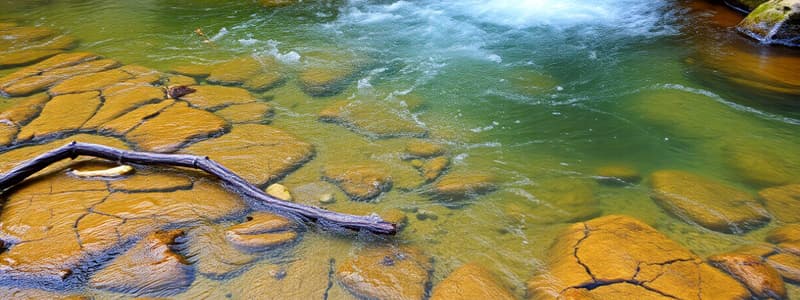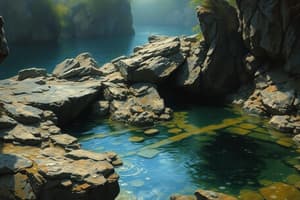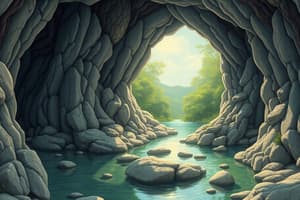Podcast
Questions and Answers
Why is surface water generally considered unsafe to drink without treatment?
Why is surface water generally considered unsafe to drink without treatment?
Surface water may contain contaminants like bugs, dirt, minerals, or chemicals.
Name one use for rainwater collected in tanks, besides drinking.
Name one use for rainwater collected in tanks, besides drinking.
Watering gardens.
What are two factors that affect the water flow in springs?
What are two factors that affect the water flow in springs?
Rainfall and water pressure.
What is a river's essential role in shaping the land?
What is a river's essential role in shaping the land?
What is the term for the point where two rivers meet?
What is the term for the point where two rivers meet?
Flashcards
Surface Water
Surface Water
Water found on the Earth's surface that is susceptible to contamination.
Rainwater Tanks
Rainwater Tanks
Containers used to collect rainwater, but the water collected may not be safe to drink without treatment.
Springs
Springs
Water sources where underground water naturally emerges onto the surface.
River
River
Signup and view all the flashcards
Upper Course (of a River)
Upper Course (of a River)
Signup and view all the flashcards
Study Notes
- Surface water from any source is generally unsafe to drink because it often contains contaminants.
- Rainwater tanks collect surface water, which is useful for watering gardens or washing cars.
- Ensure gutters are cleaned to avoid contamination if rainwater is used for drinking.
Other Water Sources
- Waterholes, rock holes, and springs combine groundwater and surface water.
Rock Holes
- Rock holes form in rocky areas and hold surface water.
- These are crucial for Aboriginal people in arid Australia, providing water in dry landscapes and aiding travel.
Springs
- Springs occur when underground aquifer water surfaces naturally.
- Flow volume depends on water pressure in the aquifer, rainfall, and human use.
- Spring water is usually clear but can be discolored by ground minerals
Rivers
- Rivers are natural streams of water flowing over land, essential for human civilization.
- These provide freshwater to people, plants, and animals, serve as transport routes, provide water power, and shape the land.
- Rivers carve out valleys and canyons over time.
River Stages
- Rivers have three stages: upper, middle, and lower course
The Upper Course
- Rain gathers in highland areas, forming streams that flow downhill, joining others and growing in size and speed.
- A confluence is where two rivers join.
- The river rapidly cuts through land, picking up soil and gravel and creating canyons and deep valleys.
The Middle Course
- The river erodes the land, forming deeper, wider horse-shoe-like loops called meanders.
- The river flows down gentler slopes, growing larger and slower, and soil, gravel, and sand sink to the bottom, forming sandbars and islands.
The Lower Course
- The river flows slowly across flatland, depositing eroded material.
- The river flows slowly and drops solid material, which may form a delta where the river meets the sea.
Erosion and Deposition
- Rivers do not travel in straight lines to overcome obstacles downhill.
- This allows for the erosion and deposition to change the shape of the river.
- Erosion is when materials, like soil or rocks, are moved by wind or water, and these are called sediments.
- Deposition is when sediments drop off in new locations.
- Rivers demonstrate deposition by dropping materials from erosion in new locations.
- Rivers often appear brown or murky from the materials they carry.
- Rivers deposit sediments into lakes or oceans, changing the water's color.
Meanders
- Meanders can merge, causing the water to take a newer, shorter route.
- Deposition of sediments can block off the old river path, forming an oxbow lake.
Studying That Suits You
Use AI to generate personalized quizzes and flashcards to suit your learning preferences.




